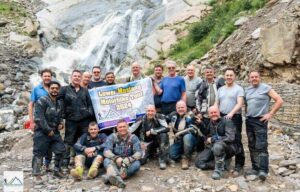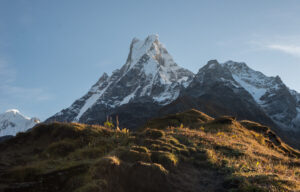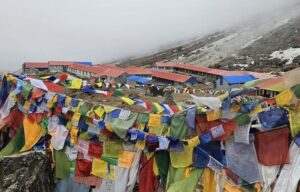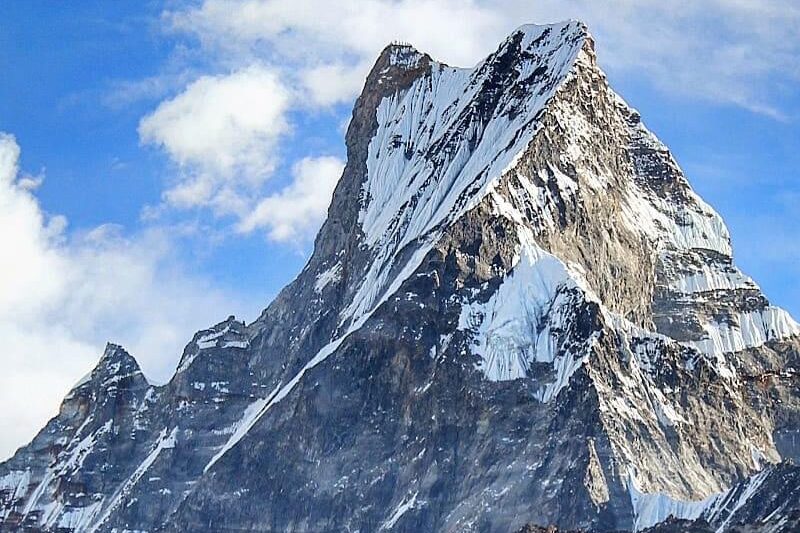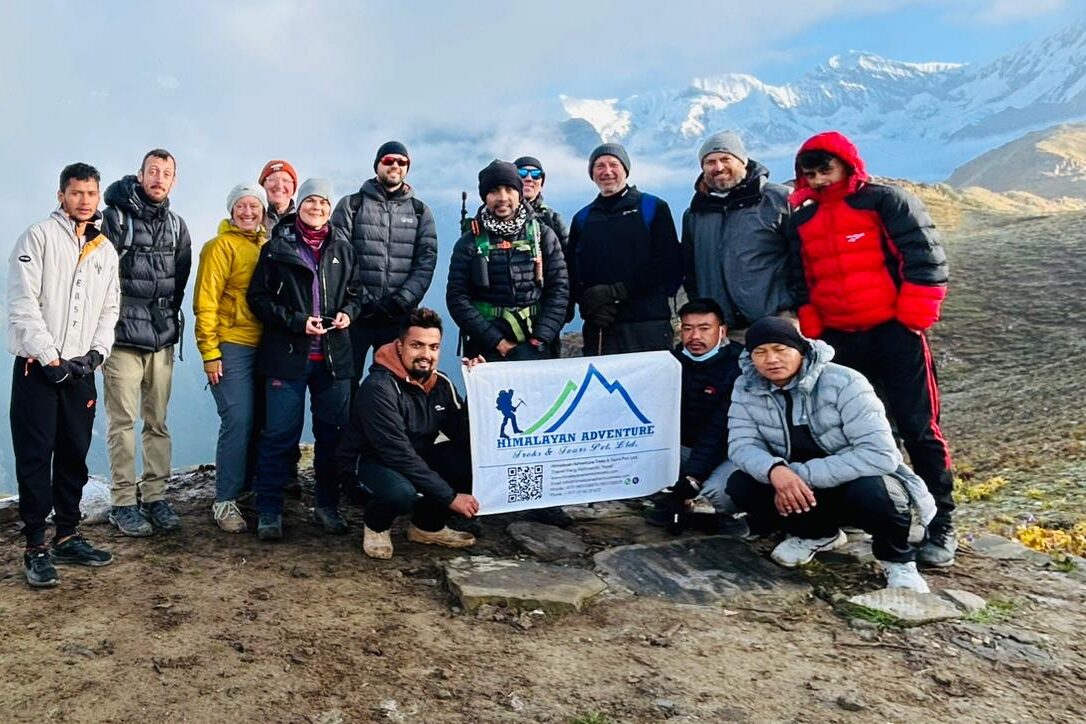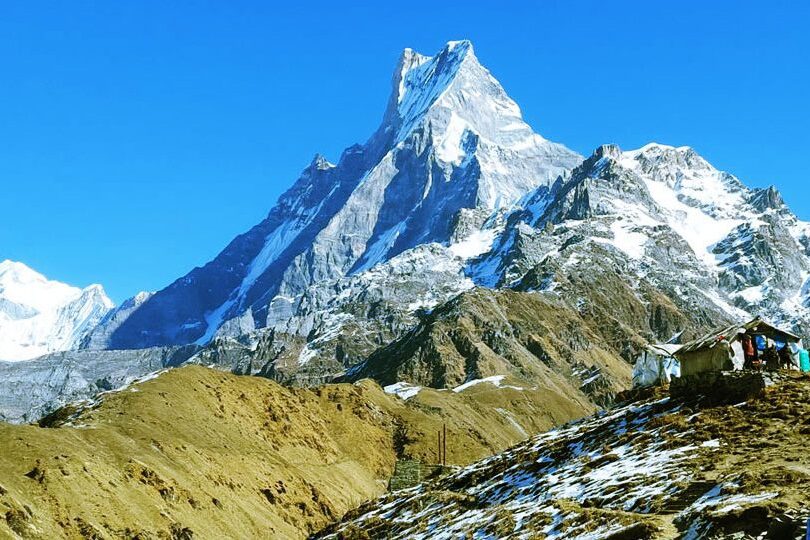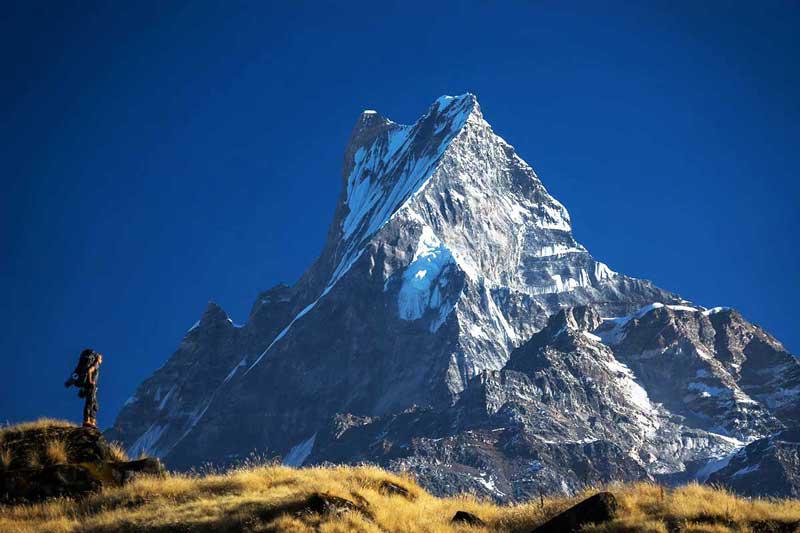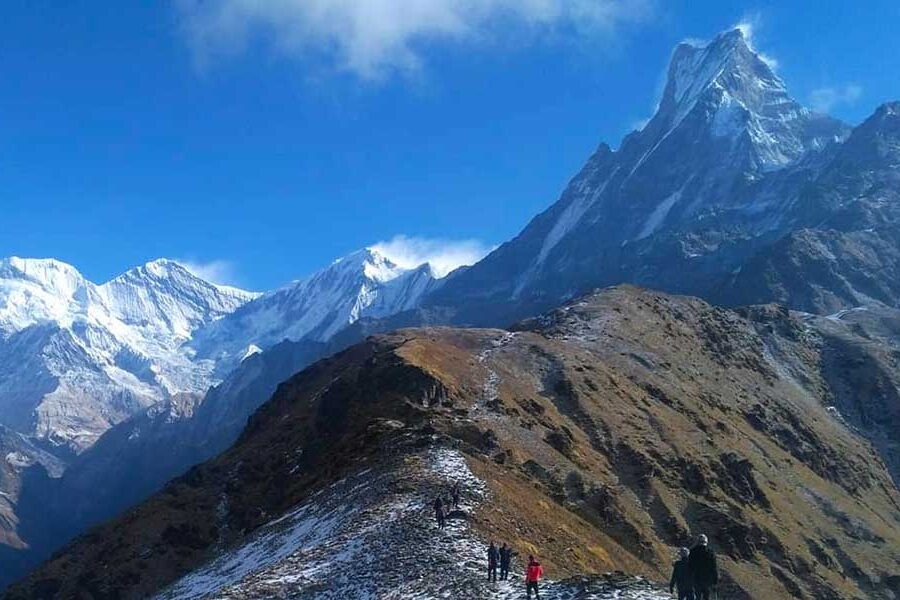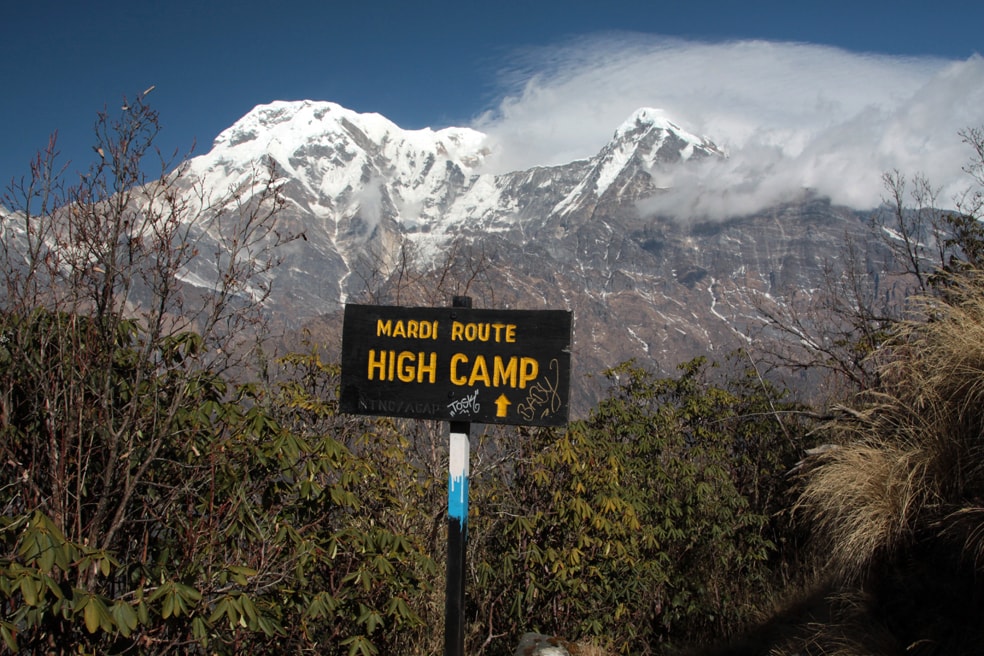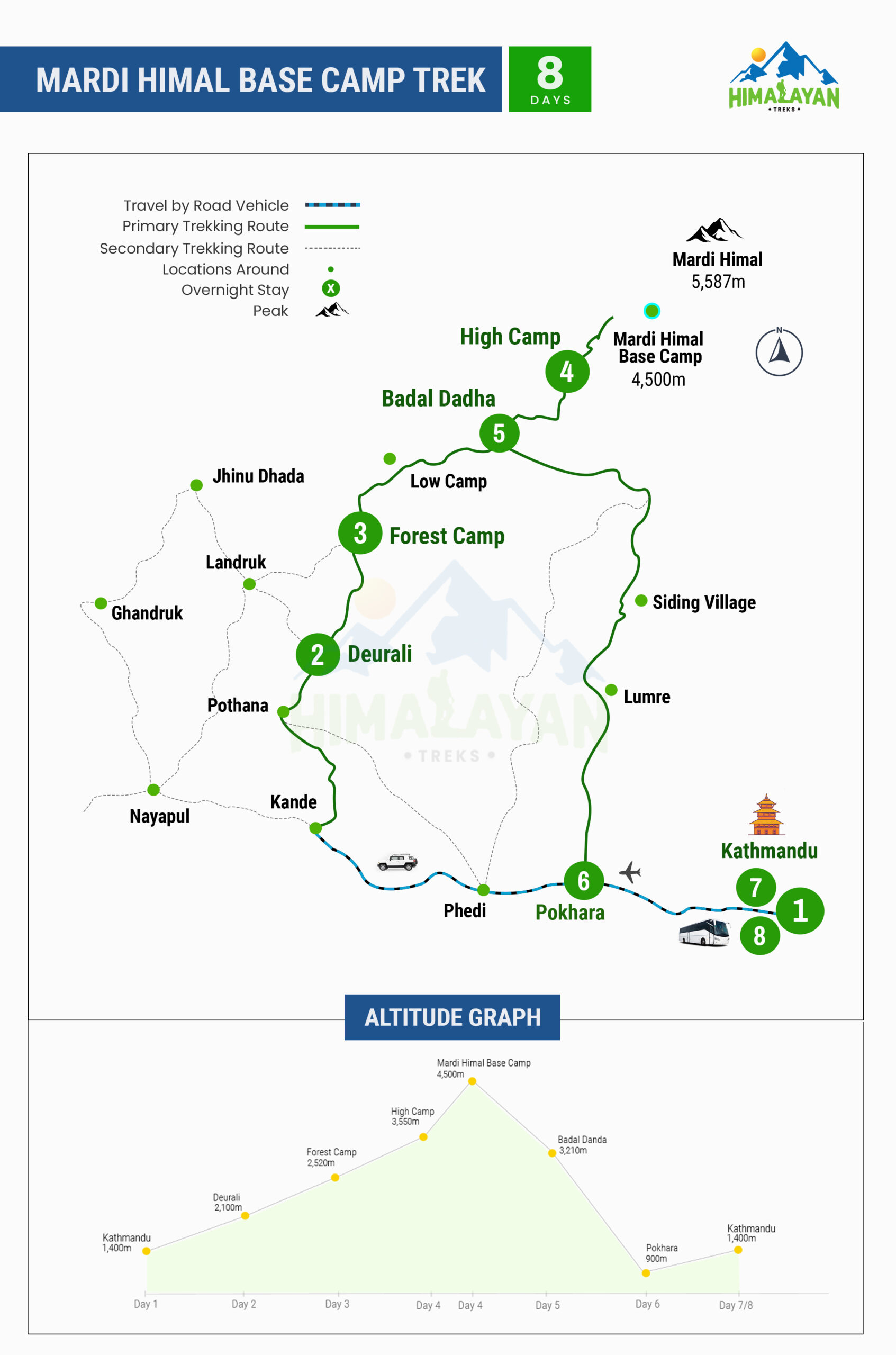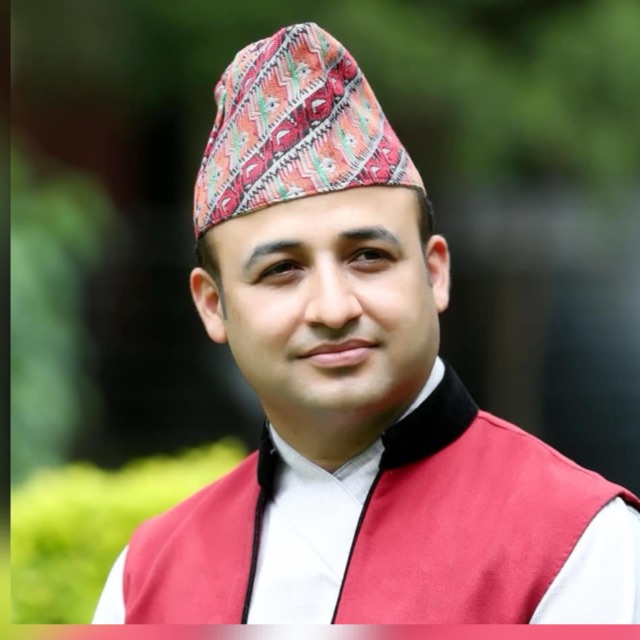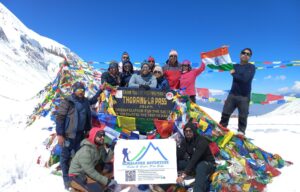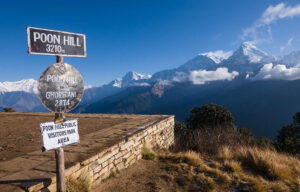Mardi Himal Base Camp Trek is the adventure of a lifetime, but proper preparation and understanding of essential information are key to a safe and enjoyable experience. In this comprehensive guide, we’ll delve into every aspect of the trek, from trekking difficulty and altitude sickness to permits and packing essentials, ensuring you’re well–equipped for the journey ahead.
Trekking Difficulty
The trek to Mardi Himal Base Camp is renowned for its moderate difficulty level, making it accessible to trekkers with a reasonable fitness level and prior trekking experience. However, knowing the challenges of trekking in the Himalayas is essential. The trail involves steep ascents and descents, often on uneven terrain, and reaches altitudes above 4000 meters. Trekkers should be prepared for long days of walking, with average daily trekking durations ranging from 4 to 8 hours.
To prepare for the trek, it’s advisable to undertake a fitness regimen that includes cardiovascular exercises, strength training, and hiking on varied terrain. Building endurance and strength in the months leading up to the trek will help minimize
fatigue and reduce the risk of injury. Additionally, acclimatization plays a crucial role in adapting to high altitudes and preventing altitude sickness. Trekkers should ascend gradually, allowing their bodies time to adjust to the decreased oxygen levels at higher elevations.
Altitude Sickness
Altitude sickness, or acute mountain sickness (AMS), is a common concern for trekkers undertaking high–altitude adventures like the Mardi Himal Base Camp Trek. It occurs when the body fails to acclimatize adequately to the reduced oxygen levels at higher altitudes, leading to symptoms such as headaches, nausea, dizziness, fatigue, and difficulty sleeping. In severe cases, altitude sickness can progress to more serious conditions like high altitude cerebral edema (HACE) and high altitude pulmonary edema (HAPE), which require immediate medical attention.
To mitigate the risk of altitude sickness, trekkers should adhere to the principles of gradual ascent, staying hydrated, and listening to their bodies. It’s crucial to pace oneself, take frequent breaks, and avoid overexertion, particularly during the initial days of the trek when ascending to higher altitudes. Drinking plenty of water and staying hydrated helps combat the effects of altitude, while avoiding alcohol and caffeine, which can contribute to dehydration. Trekkers experiencing symptoms of altitude sickness should communicate openly with their guide and consider descending to lower elevations if symptoms persist or worsen.
Best Time to Trek
Choosing the right time to undertake the Mardi Himal Base Camp Trekking is essential for a memorable and enjoyable experience. The trek is best enjoyed during the spring (March to May) and autumn (September to November) seasons when the weather is generally stable, with clear skies and mild temperatures. During these months, the lush vegetation of the lower valleys is in full bloom, while the high mountain passes offer panoramic views of snow–capped peaks against a backdrop of azure skies.
Spring is especially popular for trekking in the Annapurna region, as the rhododendron forests burst into bloom with vibrant red, pink, and white hues, creating a stunning contrast against the verdant landscape. Conversely, autumn offers crisp, clear days with excellent visibility, making it ideal for capturing breathtaking photographs of the Himalayan scenery. Both seasons provide optimal trekking conditions, with comfortable temperatures and minimal rainfall, allowing trekkers to immerse themselves fully in the beauty of the Himalayas.
Permits and Fees
Trekking in the Annapurna region, including the Mardi Himal Base Camp Trek, requires obtaining necessary permits and paying applicable fees to access the trekking trails and conservation areas. The primary permits required for the trek are the TIMS (Trekkers‘ Information Management System) card and the Annapurna Conservation Area Permit (ACAP).
The TIMS card is a mandatory trekking permit issued by the Nepal Tourism Board. It serves as a record of trekkers‘ information, including their name, nationality, trekking route, and emergency contact details. It helps track trekkers‘ movements and provides valuable data for search and rescue operations in case of emergencies. Trekkers can obtain the TIMS card through authorized trekking agencies in Kathmandu or Pokhara by presenting their passport, visa, and two passport–sized photos.
In addition to the TIMS card, trekkers must obtain the Annapurna Conservation Area Permit (ACAP) to enter the Annapurna Conservation Area, which encompasses the Mardi Himal trekking route. The ACAP aims to preserve the natural and cultural heritage of the region by regulating tourist activities and managing conservation efforts. Trekkers can purchase the ACAP at the entrance gates of the conservation area or through authorized agencies in Kathmandu or Pokhara. The permit fees vary depending on the trek’s duration and the trekkers’ nationality, with discounted rates available for SAARC (South Asian Association for Regional Cooperation) nationals.
It’s essential to carry the TIMS card and ACAP with you during the trek, as trekking permits are subject to inspection by park authorities at various checkpoints along the trail. Failure to produce valid permits may result in fines or expulsion from the conservation area, so trekkers should ensure they have all necessary documents before embarking on the trek.
Accommodation and Facilities
Accommodation along the Mardi Himal Base Camp Trek is provided in teahouses or lodges strategically located along the trekking route. Teahouses are basic but comfortable guesthouses that offer a range of amenities to cater to trekkers’ needs. The facilities vary depending on the location and elevation of the teahouse, with more basic accommodations at higher altitudes.
Generally, teahouses provide shared rooms with twin beds or dormitory-style accommodation with bunk beds. Bedding and blankets are provided, but trekkers may bring their sleeping bags for warmth and comfort, especially during the colder months. Most teahouses have common dining areas where trekkers can enjoy hearty meals and socialize with fellow travelers. The menus typically offer a variety of Nepali, Tibetan, and international dishes, including dal bhat (rice and lentils), momos (dumplings), pasta, noodles, and soups.
While teahouses provide a comfortable resting place for trekkers, the facilities are relatively basic, particularly at higher elevations. Shared toilet facilities, often squat-style or pit toilets, are common, while showers may be available for an additional fee. Hot water for showering is typically heated using solar panels or wood-fired boilers, so trekkers should be prepared for limited access to hot water, especially in remote areas.
Trekkers are encouraged to bring essential toiletries, including toilet paper, hand sanitizer, and biodegradable soap, as supplies may be limited or unavailable in some teahouses. Additionally, carrying a headlamp or flashlight for navigating the teahouses at night is advisable, as electricity may be unreliable or unavailable in remote areas.
Packing Essentials
Packing for the Mardi Himal Base Camp Trekking requires careful consideration of essential items to ensure your safety, comfort, and enjoyment throughout the journey. While it’s crucial to pack light to minimize the weight of your backpack, it’s equally important to include all necessary gear and equipment for trekking in the Himalayas. Here’s a comprehensive packing list of essentials for the Mardi Himal Base Camp Trek:
- Trekking Boots: Sturdy, waterproof trekking boots with good ankle support are essential for navigating the varied terrain of the trek, including rocky trails, muddy paths, and snow-covered slopes. It’s advisable to break in your boots before the trek to prevent blisters and discomfort.
- Clothing Layers: Layered clothing is essential for adjusting to changing weather conditions and temperature fluctuations along the trekking route. Pack lightweight, moisture-wicking base layers, insulating mid-layers, and waterproof outer layers to stay warm, dry, and comfortable throughout the trek. Include thermal underwear, fleece jackets, down vests, and waterproof jackets and pants.
- Trekking Pants: Lightweight, quick–drying trekking pants with zip–off legs are ideal for versatility and comfort during the trek. Choose pants with ample pockets for storing essentials like snacks, sunscreen, and lip balm.
- Trekking Shirts: Moisture–wicking, breathable trekking shirts made of synthetic or merino wool fibers are essential for staying cool and dry during strenuous hikes. Pack a mix of short-sleeved and long-sleeved shirts for layering options and sun protection.
- Warm Accessories: Don’t forget to pack warm accessories like hats, gloves, scarves, and neck gaiters to protect exposed skin from the cold and wind at higher elevations. Opt for lightweight, insulating materials that provide warmth without adding bulk to your backpack.
- Socks: High–quality trekking socks made of moisture–wicking merino wool or synthetic fibers are essential for preventing blisters and keeping your feet dry and comfortable during long days of hiking. Pack multiple pairs of socks to rotate throughout the trek and avoid wearing damp or sweaty socks.
- Sun Protection: Sun protection is crucial when trekking in the Himalayas, where the sun’s rays are intensified at higher altitudes. Pack sunglasses with UV protection, a wide-brimmed hat or cap, and sunscreen with a high SPF rating to shield your skin and eyes from harmful UV radiation.
- Backpack: A comfortable, well–fitted backpack with padded shoulder straps and a hip belt is essential for carrying your gear and essentials during the trek. Choose a backpack with 40-50 liters capacity, with compartments for organization and easy access to items like water bottles, snacks, and a camera.
- Sleeping Bag: A lightweight, compact sleeping bag rated for cold temperatures is essential for staying warm and comfortable during nights spent in teahouses along the trekking route. Choose a sleeping bag with a temperature rating suitable for the expected weather conditions during your trek.
- Water Bottle or Hydration System: Staying hydrated is crucial for maintaining energy levels and preventing altitude sickness during the trek. Carry a reusable water bottle or hydration system capable of holding at least 2-3 liters of water and refill it regularly at teahouses or water sources along the trail. 11. Trekking Poles: Trekking poles provide stability, balance, and support on uneven terrain, particularly during steep ascents and descents. Consider bringing adjustable trekking poles with ergonomic grips and wrist straps to reduce strain on your joints and muscles.
- First Aid Kit: A well–stocked kit containing essential medications and supplies for treating common injuries and ailments is essential for emergencies during the trek. Include pain relievers, adhesive bandages, blister pads, antiseptic wipes, and oral rehydration salts.
- Headlamp or Flashlight: A compact, lightweight headlamp or flashlight with extra batteries is essential for navigating teahouses and trails after dark. Choose a hands–free lighting option with adjustable brightness settings for versatility and convenience.
- Personal Toiletries: Pack essential toiletries such as toothpaste, toothbrush, biodegradable soap, shampoo, conditioner, and toilet paper in a waterproof, sealable bag to keep them dry and organized during the trek.
- Camera or Smartphone: Use a digital camera or smartphone to capture stunning photographs and videos of the breathtaking landscapes, mountain vistas, and cultural experiences along the Mardi Himal Base Camp Trek. Bring extra memory cards and batteries to ensure you never miss a moment.
- Portable Charger: A portable charger or power bank is essential for keeping your electronic devices charged and powered up during the trek, particularly if you use your smartphone for navigation, photography, or communication.
- Trekking Map and Guidebook: Carry a detailed trekking map and guidebook of the Annapurna region to navigate the trails, identify landmarks, and plan your route. Waterproof, tear-resistant maps and guidebooks are ideal for durability and longevity on the trail.
- Personal Identification and Documents: Keep your passport, trekking permits, insurance documents, and emergency contact information in a waterproof, sealable bag or pouch for safekeeping and easy access during the trek.
Health and Safety
Prioritizing health and safety is paramount when undertaking the Mardi Himal Base Camp Trek, as the rugged terrain and high altitudes present inherent risks and challenges. Trekkers should proactively manage their health and well–being throughout the journey, taking precautions to prevent injuries, illnesses, and altitude–related issues. Here are some essential health and safety tips to consider:
- Physical Fitness: Prepare your body for the physical demands of trekking by engaging in regular exercise, including cardiovascular workouts, strength training, and hiking on varied terrain. Focus on building endurance, strength, and flexibility to minimize fatigue and prevent injuries during the trek.
- Altitude Acclimatization: Allow your body time to acclimatize to the high altitudes gradually by ascending slowly and taking rest days to adjust to the reduced oxygen levels. Follow the principles of “climb high, sleep low” to minimize the risk of altitude sickness and allow your body to adapt to higher elevations.
- Hydration and Nutrition: Drink plenty of fluids throughout the trek, including water, electrolyte-rich beverages, and herbal teas. Eat balanced meals with carbohydrates, proteins, and healthy fats to fuel your body and maintain energy levels during long days of hiking.
- Sun Protection: Protect your skin and eyes from the sun’s harmful UV rays by wearing sunscreen with a high SPF rating, lip balm with UV protection, sunglasses with polarized lenses, and a wide-brimmed hat or cap. Apply sunscreen generously and reapply frequently, especially at higher altitudes where UV radiation is intensified.
- Weather Preparedness: Be prepared for changing weather conditions along the trekking route, including cold temperatures, strong winds, rain, and snow. Dress in layers to regulate your body temperature and adjust clothing to stay warm and dry in varying weather conditions.
- Foot Care: Take care of your feet by wearing well–fitted, broken–in trekking boots with good ankle support and cushioned socks. Check your feet regularly for signs of blisters, hotspots, or discomfort, and treat any minor injuries promptly to prevent infection and further irritation.
- Personal Hygiene: Maintain good personal hygiene practices throughout the trek by washing your hands regularly with soap and water, especially before meals and after using the toilet. Use hand sanitizer or antibacterial wipes when soap and water are unavailable, and avoid touching your face to prevent the spread of germs.
- Emergency Preparedness: Familiarize yourself with basic first aid techniques and know how to recognize and respond to common injuries, illnesses, and altitude-related symptoms. Carry a well-stocked first aid kit with essential medications and supplies for treating minor injuries and ailments, and know when to seek medical help or evacuation in emergencies.
- Travel Insurance: Before embarking on the trek, purchase comprehensive travel insurance with coverage for medical emergencies, evacuation, trip cancellation, and personal liability. Verify that your insurance policy includes coverage for high-altitude trekking activities and provides adequate protection for the duration of your trip.
- Guided Trekking: Consider joining a guided trekking group led by experienced local guides and porters familiar with the region’s terrain, weather conditions, and culture. Trekking with a knowledgeable guide enhances safety, provides valuable insights into the local environment and customs, and offers peace of mind, knowing you’re in capable hands throughout the journey.
Responsible Trekking
Responsible trekking practices are essential for preserving the Himalayan region’s natural beauty, cultural heritage, and ecological balance for future generations to enjoy. As stewards of the environment, trekkers have a responsibility to minimize their impact on fragile ecosystems and respect the local communities and traditions of the places they visit. Here are some guidelines for responsible trekking in the Annapurna region:
- Leave No Trace: Follow the principles of “Leave No Trace” by minimizing your environmental impact and leaving the trekking trails and campsites cleaner than you found. Pack out all waste, including food wrappers, tissue paper, and biodegradable items, and dispose of it properly in designated trash bins or carry-out bags.
- Respect Local Culture: Respect the customs, traditions, and beliefs of the local communities you encounter along the trekking route, including indigenous peoples and ethnic minorities. Ask for permission before taking photographs of people or religious sites, and refrain from engaging in behaviors that may be offensive or disrespectful to local customs.
- Support Local Economy: Support local communities and businesses by purchasing locally-made goods, souvenirs, and services, including meals, accommodations, and guided tours. Patronize family-run teahouses, lodges, and shops, prioritizing sustainability, fair wages, and community development initiatives.
- Conserve Natural Resources: Use natural resources such as water, fuel, and energy responsibly and efficiently during the trek. Take shorter showers, turn off lights and electronics when not in use, and minimize water usage for washing dishes and laundry to reduce environmental impact.
- Minimize Plastic Waste: Reduce plastic waste by carrying reusable water bottles, food containers, and utensils and avoiding single-use plastic items such as water bottles, straws, and shopping bags. Refill water bottles at water stations or filtered sources along the trekking route, and refuse plastic packaging whenever possible.
- Stay on Designated Trails: Stick to designated trekking trails and avoid creating new paths or shortcuts that can damage fragile vegetation and disrupt wildlife habitats. Follow trail markers, signposts, and guidebook directions to navigate the route safely and minimize soil erosion and environmental degradation.
- Practice Safe Campfire Use: If camping along the trekking route, use designated fire pits or stoves for cooking and heating. Avoid lighting open fires or burning wood from live trees, as this can damage ecosystems and contribute to deforestation and air pollution.
- Educate and Inspire: Educate yourself and others about responsible trekking practices and inspire fellow trekkers to adopt sustainable behaviors and attitudes towards the environment and local communities. Lead by example and encourage others to positively impact the places they visit through responsible tourism and eco-friendly practices.
Conclusion
After engaging yourself in the stunning Mardi Himal Base Camp Trek adventure, it’s time to turn your dreams into reality. Don’t let this once-in-a-lifetime opportunity slip away. Book your trek now and experience the awe-inspiring beauty of the Himalayas firsthand.
Our professional guides are ready to lead you through lush forests, charming villages, and stunning mountain vistas. You’ll create memories that last a lifetime while supporting local communities and maintaining this fresh environment.
Take the first step towards your Himalayan experience today. Contact us to secure your spot on the next Mardi Himal Base Camp Trek. The mountains are calling – will you answer?
